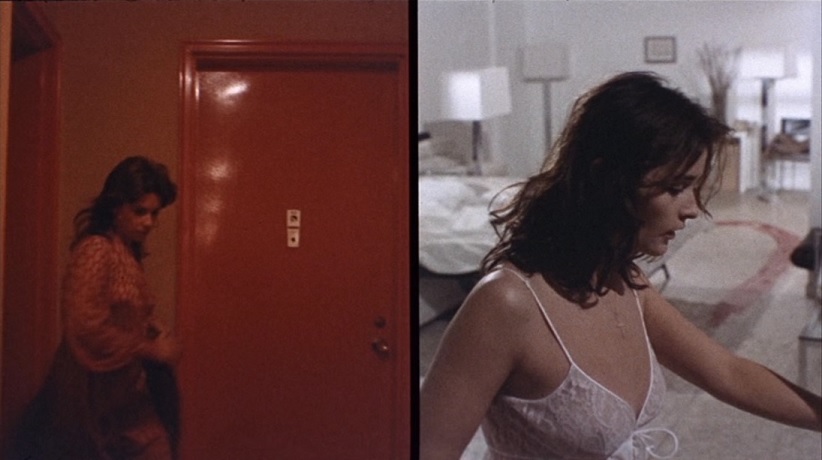SAYS ANNE BILLSON AT THE GUARDIAN, DISCUSSING SPLIT-SCREENS & VARYING ASPECT RATIOS

In an article today with the headline, "You’ve been reframed: how playing with split-screen and aspect ratio went mainstream," The Guardian's Anne Billson offers a concise sort of chronology of the use of split-screen in cinema:
Michael Bay once described his bombastic film-making style as “fucking the frame”, but if any director fornicates with the frame it must surely be Gaspar Noé, who blitzes us with flashing neon, 360-degree camera movements and intercourse closeups. So it’s a surprise when his new film, Vortex, begins with an elderly married couple (played by Françoise Lebrun and Italian horror maestro Dario Argento) sitting serenely on their Paris balcony.When the soundtrack plays a lovely Françoise Hardy song, you wonder if Noé has mellowed. But wait! If he doesn’t actually shag the frame here, he fiddles with it in two ways. First, the square-ish Academy ratio (1.37:1) of the serene prologue expands into a letterbox shape. Second, that widescreen divides into two side-by-side images, shot simultaneously with two cameras, enabling us to watch as Lebrun’s character, stricken by dementia, meanders around their cluttered flat, while Argento’s, wrestling with health issues of his own, nixes their adult son’s suggestion they move into a care home. Vortex could be Noé’s toughest watch yet – but this is due to its brutal honesty, and not because of the split-screen, which pays devastating emotional dividends.
Most of today’s cutting-edge directors have at some point used split-screen sequences in their films. The effect still seems mildly adventurous, though it has been around since the birth of cinema. Lois Weber’s Suspense (1913) uses an innovative triangular split that still looks startling. In the last reel of Abel Gance’s 1927 epic Napoléon, the Academy screen opens out into three sets of film projected side by side to form a widescreen triptych. Split-screen was often used, with unobtrusive matting, to show one actor playing identical twins in the same frame, or as a witty ploy to sidestep censorship, making it look as though unmarried couples, such as Ingrid Bergman and Cary Grant in Indiscreet, or Doris Day and Rock Hudson in Pillow Talk, are sharing a bed rather than just talking to each other on the phone.
Split-screen is perfect for phone calls: see Mean Girls. But as Guy Ritchie’s retro-styled The Man from Uncle reminded us, it’s an aesthetic we associate with the 1960s. Genius credits designer Saul Bass used split-screen montage for the opening of Grand Prix (1966); when Film Dope asked him about the technique a few years later he said: “I think it is terrific at expressing muchness, but I suspect it’s not capable of expressing deep feeling.” Bass’s split-screen is based on multiplication of a single image, but one year after Grand Prix, Christopher Chapman demonstrated his innovative “multidynamic image technique” in A Place to Stand, a landmark short made for the Ontario pavilion at Expo 67 in Montreal. (Earworm warning: I saw this film 50 years ago, and the maddening theme song has been lodged in my head ever since.) Chapman presents multiple panes in various sizes and shapes on a single screen; sometimes the images in the panes move independently, sometimes as components of one big picture.
Steve McQueen saw A Place to Stand at an advance screening in Hollywood and was impressed. One year later, Norman Jewison inserted split-screen sequences into The Thomas Crown Affair, including the opening credits, and McQueen playing polo. That same year, in The Boston Strangler, Richard Fleischer divided his screen to show a creepy phone caller, the recipient of the call, and the call being traced, all at once. Spilt-screen enabled Michael Wadleigh, director-cinematographer of Woodstock, to show crowd reactions in the same frame as the performers, while in 1973, Soylent Green employed it in the opening credits to encapsulate the “muchness” of proliferating industrialism and pollution.
The director most associated with split-screen is Brian De Palma, who turned it into an operatic art form. In Sisters, he shows the point of view of a dying murder victim at the same time as a witness looking back at him, and in Phantom of the Paradise he ramps up tension between the planting of a bomb and its explosion. Many mainstream audiences encountered split-screen for the first time in Carrie, when the traumatised antihero wreaks telekinetic carnage at her prom. De Palma told Cinefantastique magazine: “I felt the destruction had to be shown in split-screen, because how many times could you cut from Carrie to things moving around? You can overdo that.”



